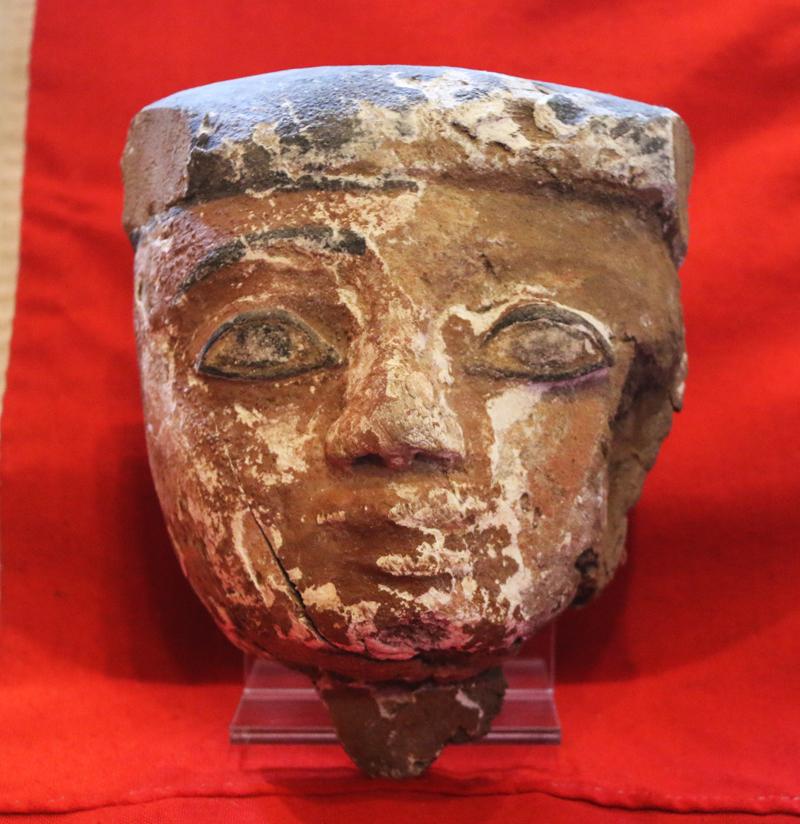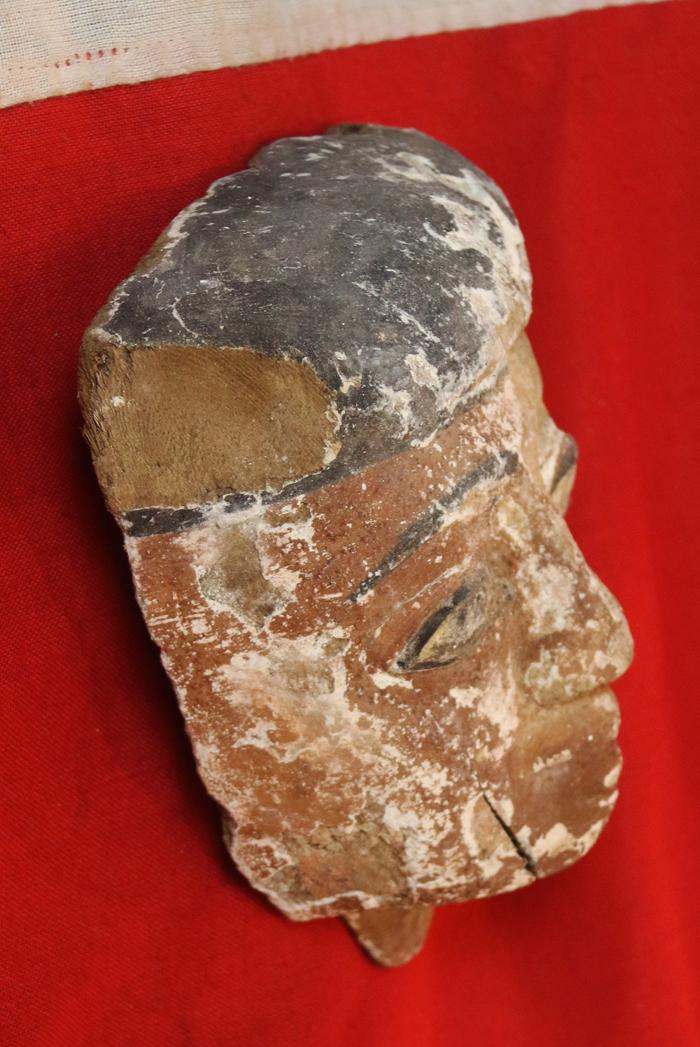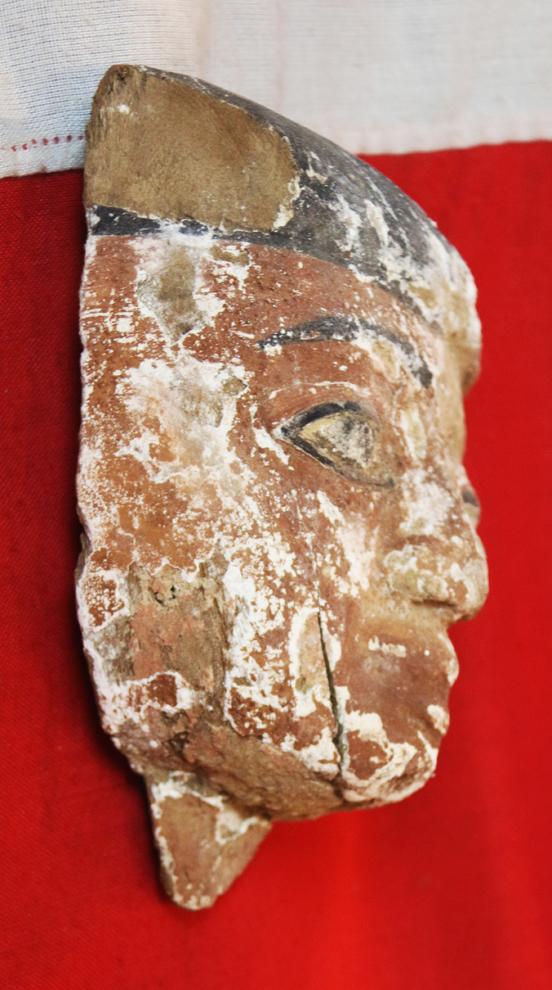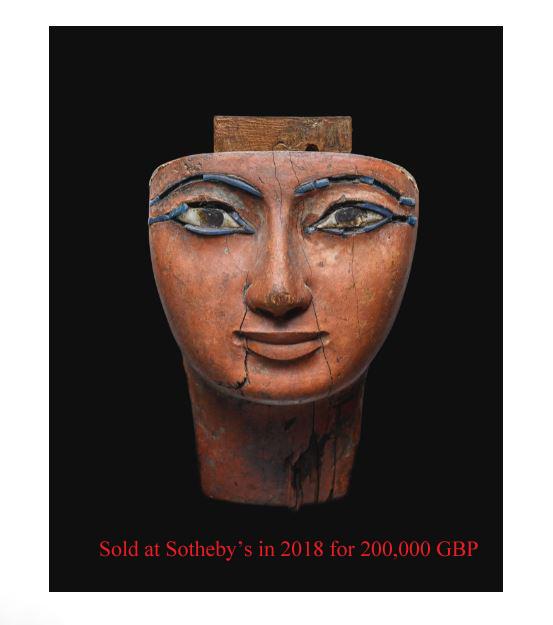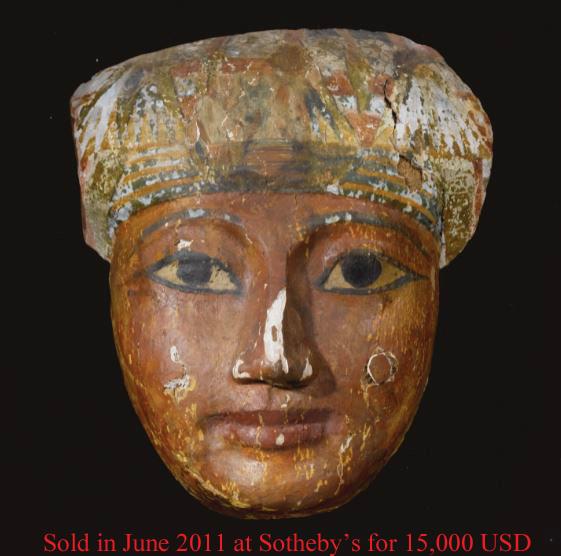A Fabulous Original Egyptian Carved Wooden Mummy Mask 25th to 26th Dynasty Period to late Dynastic Period
Around 2700 to 2350 years old.
Beautifully painted over a gesso type plaster on cedar wood, with a substantial amount of paint remaining, showing excellent flesh tones, probably bronze insert eye lines with white painted eyes and large black pupils.
Piye established the Twenty-fifth Dynasty and appointed the defeated rulers as his provincial governors. He was succeeded first by his brother, Shabaka, and then by his two sons Shebitku and Taharqa. The reunited Nile valley empire of the 25th Dynasty was as large as it had been since the New Kingdom. Pharaohs of the dynasty, among them Taharqa, built or restored temples and monuments throughout the Nile valley, including at Memphis, Karnak, Kawa, and Jebel Barkal. The 25th Dynasty ended with its rulers retreating to their spiritual homeland at Napata. It was there (at El-Kurru and Nuri) that all 25th Dynasty pharaohs were buried under the first pyramids to be constructed in the Nile valley in hundreds of years
A mummy mask provided protection – both physical and magical – to the head of the mummy. Masks were introduced in the First Intermediate Period (c. 2181-2955 BC) and were used until Roman times (30BC-395AD). They show the deceased in an idealised form, like a god who has triumphed over death. The use of gilding on masks of the wealthy symbolises the golden skin of the gods.
Spell 151 from the Book of the Dead – the ‘Spell for the Head-of-Mystery’ – makes the function of the mask explicit:
Anubis speaks, the embalmer, lord of the divine hall, when he has placed his hands on the coffin of the deceased and equipped him with what he needs: ‘Hail, O beautiful of face, lord of vision, whom Ptah-Sokar has gathered together and whom Anubis has upraised, to whom Shu gave support, O beautiful of face among the gods!
Your right eye is the night boat, your left eye is the day boat, your eyebrows are the Ennead. The crown of your head is Anubis, the back of your head is Horus, your fingers are Thoth, your lock of hair is Ptah-Sokar. You the mask are in front of the deceased, he sees by means of you. You lead him on the goodly ways, you repel Seth’s band for him and cast his enemies under his feet for him in front of the Ennead of the great House of the Noble in Heliopolis. You take the goodly way to the presence of Horus, the lord of the nobles.’
This text appears on the famous golden mask of Tutankhamun, inscribing an object with its function in order to ensure that it would ‘work’ for the dead king. The spell makes clear that the mask was to protect the deceased (magically) from their enemies. As is common in such spells, the text is a command from a god to an inanimate object – divine authority used to spark to life a lifeless substance.
The spell emphasises the power of the mask to restore to the deceased the ability to see. An important part of the funeral ritual was a rite known as the ‘Opening of the Mouth’, which restored the power of speech, as well as the other senses to the mummy (set up outside the tomb, probably wearing the mummy mask). The senses were required for a successful rebirth into in the afterlife as a fully-functioning person, as in life.
Masks were made to give their owners the power of sight – and speech.
To show how mummy masks have become so desirable and collectable we show two masks sold in Sotheby's 2011 for 15,000 USD and the other one sold for 200,000 GBP in 2018.
Another photo shows a similar mask discovered recently but lacking paint to the face, being cleaned by the Cairo museum conservator.
The other photos are of Amenhotep I and his very similar mask still in place, we also show his outer sarcophagus.
Amenhotep I's Horus and Two Ladies names, "Bull who conquers the lands" and "He who inspires great terror," are generally interpreted to mean that Amenhotep I intended to dominate the surrounding nations. Two tomb texts indicate that he led campaigns into Nubia. According to the tomb texts of Ahmose, son of Ebana, Amenhotep later sought to expand Egypt's border southward into Nubia and he led an invasion force which defeated the Nubian army. The tomb biography of Ahmose Pen-Nekhebet says he also fought in a campaign in Kush, however it is quite possible that it refers to the same campaign as Ahmose, son of Ebana. Amenhotep built a temple at Saï, showing that he had established Egyptian settlements almost as far as the Third Cataract.
Sometime during the 20th or 21st Dynasty, Amenhotep's original tomb was either robbed or deemed insecure and emptied and his body was moved for safety, probably more than once. It was found in the Deir el-Bahri Cache, hidden with the mummies of numerous New Kingdom kings and nobles in or after the late 22nd dynasty above the Mortuary Temple of Hatshepsut and was kept in the Egyptian Museum in Cairo. His mummy had apparently not been looted by the 21st dynasty, and the priests who moved the mummy took care to keep the cartonnage intact. Because of that exquisite face mask, Amenhotep's is the only royal mummy which has not been unwrapped and examined by modern Egyptologists.
it was last acquired around 25 years after WW2 and remained since in a private collection
Every item is accompanied with our unique, Certificate of Authenticity. Of course any certificate of authenticity, given by even the best specialist dealers, in any field, all around the world, is simply a piece of paper,…however, ours is backed up with the fact we are the largest dealers of our kind in the world, with over 100 years and four generation’s of professional trading experience behind us
Just over 20 cm high. As usual with most painted masks from ancient Egypt there is a degree of shedding of gesso {a mixture of gum and chalk powder} dust
Code: 24113
7950.00 GBP


